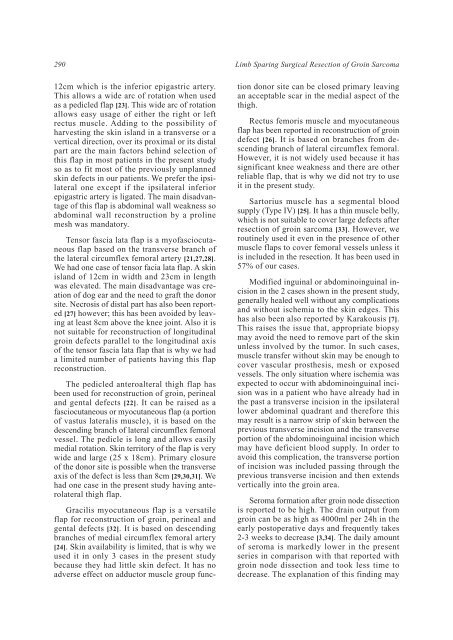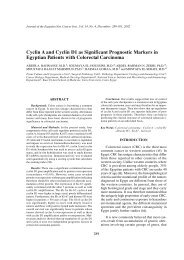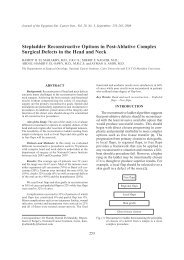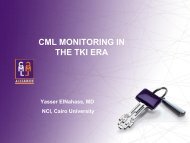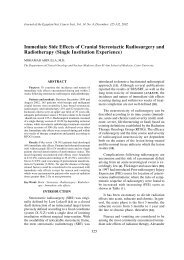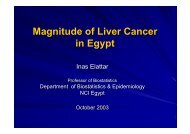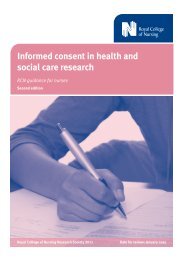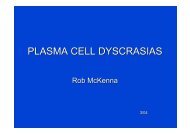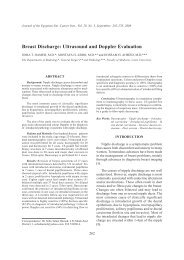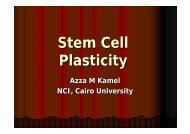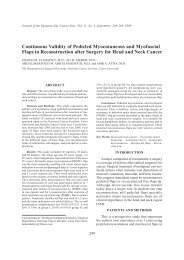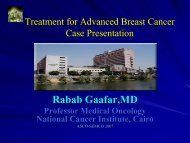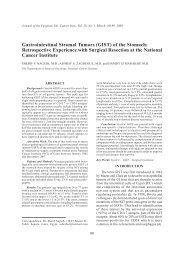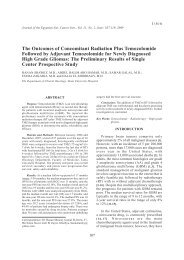Limb Sparing Surgical Resection of Groin Sarcoma. Surgical ... - NCI
Limb Sparing Surgical Resection of Groin Sarcoma. Surgical ... - NCI
Limb Sparing Surgical Resection of Groin Sarcoma. Surgical ... - NCI
Create successful ePaper yourself
Turn your PDF publications into a flip-book with our unique Google optimized e-Paper software.
29012cm which is the inferior epigastric artery.This allows a wide arc <strong>of</strong> rotation when usedas a pedicled flap [23]. This wide arc <strong>of</strong> rotationallows easy usage <strong>of</strong> either the right or leftrectus muscle. Adding to the possibility <strong>of</strong>harvesting the skin island in a transverse or avertical direction, over its proximal or its distalpart are the main factors behind selection <strong>of</strong>this flap in most patients in the present studyso as to fit most <strong>of</strong> the previously unplannedskin defects in our patients. We prefer the ipsilateralone except if the ipsilateral inferiorepigastric artery is ligated. The main disadvantage<strong>of</strong> this flap is abdominal wall weakness soabdominal wall reconstruction by a prolinemesh was mandatory.Tensor fascia lata flap is a my<strong>of</strong>asciocutaneousflap based on the transverse branch <strong>of</strong>the lateral circumflex femoral artery [21,27,28].We had one case <strong>of</strong> tensor facia lata flap. A skinisland <strong>of</strong> 12cm in width and 23cm in lengthwas elevated. The main disadvantage was creation<strong>of</strong> dog ear and the need to graft the donorsite. Necrosis <strong>of</strong> distal part has also been reported[27] however; this has been avoided by leavingat least 8cm above the knee joint. Also it isnot suitable for reconstruction <strong>of</strong> longitudinalgroin defects parallel to the longitudinal axis<strong>of</strong> the tensor fascia lata flap that is why we hada limited number <strong>of</strong> patients having this flapreconstruction.The pedicled anteroalteral thigh flap hasbeen used for reconstruction <strong>of</strong> groin, perinealand gental defects [22]. It can be raised as afasciocutaneous or myocutaneous flap (a portion<strong>of</strong> vastus lateralis muscle), it is based on thedescending branch <strong>of</strong> lateral circumflex femoralvessel. The pedicle is long and allows easilymedial rotation. Skin territory <strong>of</strong> the flap is verywide and large (25 x 18cm). Primary closure<strong>of</strong> the donor site is possible when the transverseaxis <strong>of</strong> the defect is less than 8cm [29,30,31]. Wehad one case in the present study having anterolateralthigh flap.<strong>Limb</strong> <strong>Sparing</strong> <strong>Surgical</strong> <strong>Resection</strong> <strong>of</strong> <strong>Groin</strong> <strong>Sarcoma</strong>Gracilis myocutaneous flap is a versatileflap for reconstruction <strong>of</strong> groin, perineal andgental defects [32]. It is based on descendingbranches <strong>of</strong> medial circumflex femoral artery[24]. Skin availability is limited, that is why weused it in only 3 cases in the present studybecause they had little skin defect. It has noadverse effect on adductor muscle group functiondonor site can be closed primary leavingan acceptable scar in the medial aspect <strong>of</strong> thethigh.Rectus femoris muscle and myocutaneousflap has been reported in reconstruction <strong>of</strong> groindefect [26]. It is based on branches from descendingbranch <strong>of</strong> lateral circumflex femoral.However, it is not widely used because it hassignificant knee weakness and there are otherreliable flap, that is why we did not try to useit in the present study.Sartorius muscle has a segmental bloodsupply (Type IV) [25]. It has a thin muscle belly,which is not suitable to cover large defects afterresection <strong>of</strong> groin sarcoma [33]. However, weroutinely used it even in the presence <strong>of</strong> othermuscle flaps to cover femoral vessels unless itis included in the resection. It has been used in57% <strong>of</strong> our cases.Modified inguinal or abdominoinguinal incisionin the 2 cases shown in the present study,generally healed well without any complicationsand without ischemia to the skin edges. Thishas also been also reported by Karakousis [7].This raises the issue that, appropriate biopsymay avoid the need to remove part <strong>of</strong> the skinunless involved by the tumor. In such cases,muscle transfer without skin may be enough tocover vascular prosthesis, mesh or exposedvessels. The only situation where ischemia wasexpected to occur with abdominoinguinal incisionwas in a patient who have already had inthe past a transverse incision in the ipsilaterallower abdominal quadrant and therefore thismay result is a narrow strip <strong>of</strong> skin between theprevious transverse incision and the transverseportion <strong>of</strong> the abdominoinguinal incision whichmay have deficient blood supply. In order toavoid this complication, the transverse portion<strong>of</strong> incision was included passing through theprevious transverse incision and then extendsvertically into the groin area.Seroma formation after groin node dissectionis reported to be high. The drain output fromgroin can be as high as 4000ml per 24h in theearly postoperative days and frequently takes2-3 weeks to decrease [3,34]. The daily amount<strong>of</strong> seroma is markedly lower in the presentseries in comparison with that reported withgroin node dissection and took less time todecrease. The explanation <strong>of</strong> this finding may


